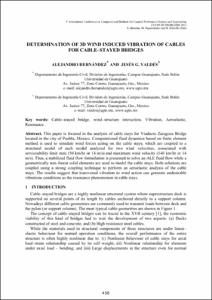Determination of 3D wind induced vibration of cables for cable–stayed bridges

Visualitza/Obre
Estadístiques de LA Referencia / Recolecta
Inclou dades d'ús des de 2022
Cita com:
hdl:2117/192347
Tipus de documentText en actes de congrés
Data publicació2013
EditorCIMNE
Condicions d'accésAccés obert
Tots els drets reservats. Aquesta obra està protegida pels drets de propietat intel·lectual i
industrial corresponents. Sense perjudici de les exempcions legals existents, queda prohibida la seva
reproducció, distribució, comunicació pública o transformació sense l'autorització del titular dels drets
Abstract
This paper is focused in the analysis of cable stays for Viaducto Zaragoza Bridge
located in the city of Puebla, Mexico. Computational fluid dynamics based on finite element
method is used to simulate wind forces acting on the cable stays, which are coupled to a
structural model of each model analyzed for two wind velocities, associated with
serviceability limit state (50 km/hr or 14 m/s) and maximum wind velocity (140 km/hr or 14
m/s). Thus, a stabilized fluid flow formulation is presented to solve an ALE fluid flow while a
geometrically non–linear solid elements are used to model the cable stays. Both solutions are
coupled using a strong coupling technique to perform an aeroelastic analysis of the cable
stays. The results suggest that transversal vibration to wind action can generate undesirable
vibrations conditions as the resonance phenomenon in cable stays.
ISBN978-84-941407-6-1
| Fitxers | Descripció | Mida | Format | Visualitza |
|---|---|---|---|---|
| Coupled-2013-39 ... ion of 3D wind induced.pdf | 1,116Mb | Visualitza/Obre |

